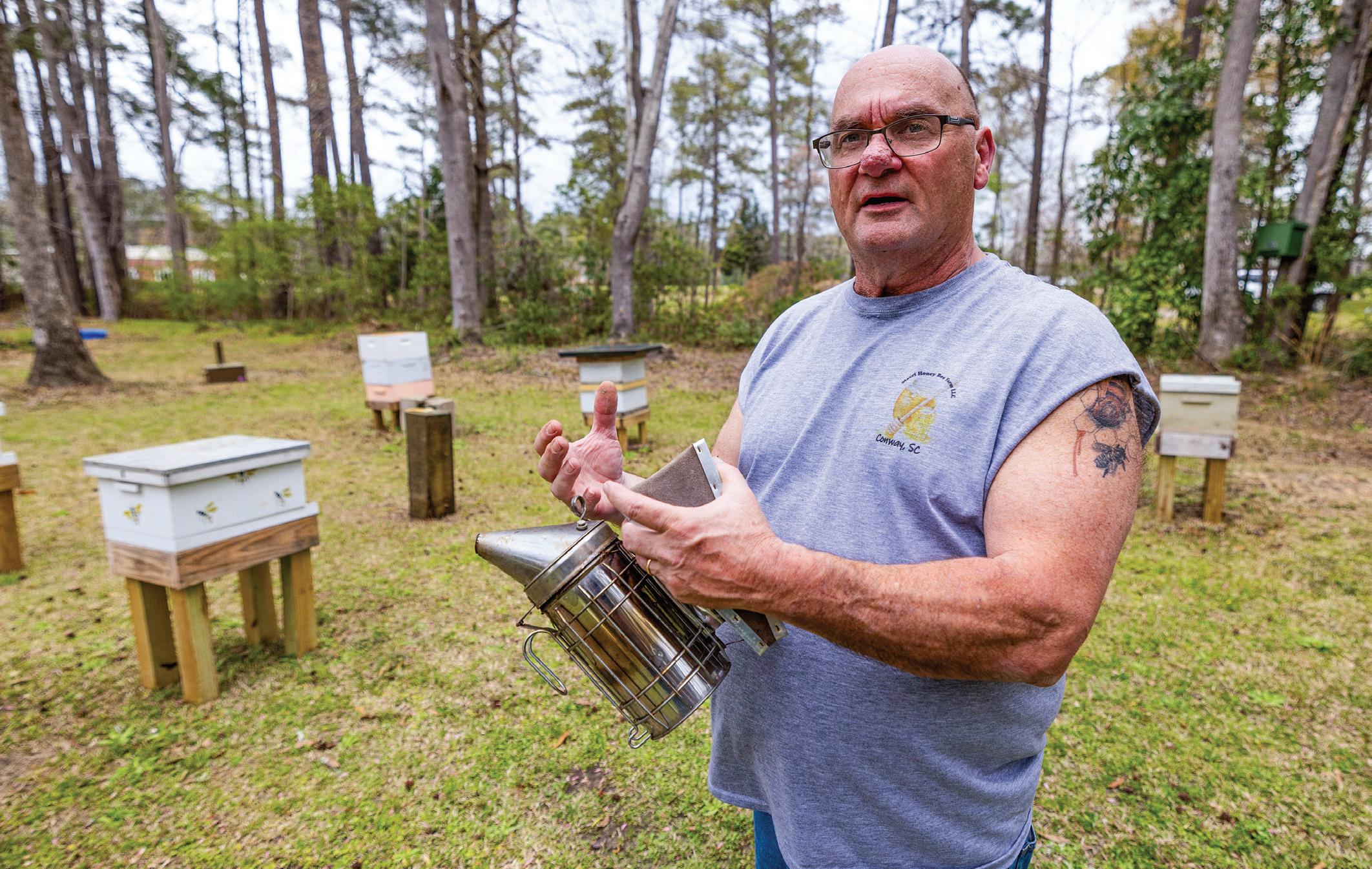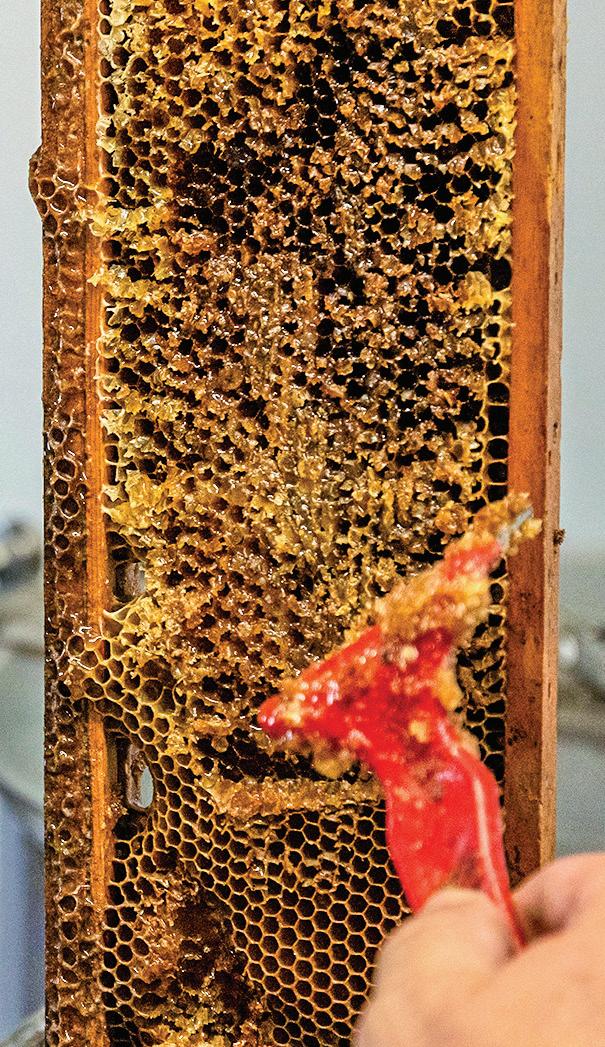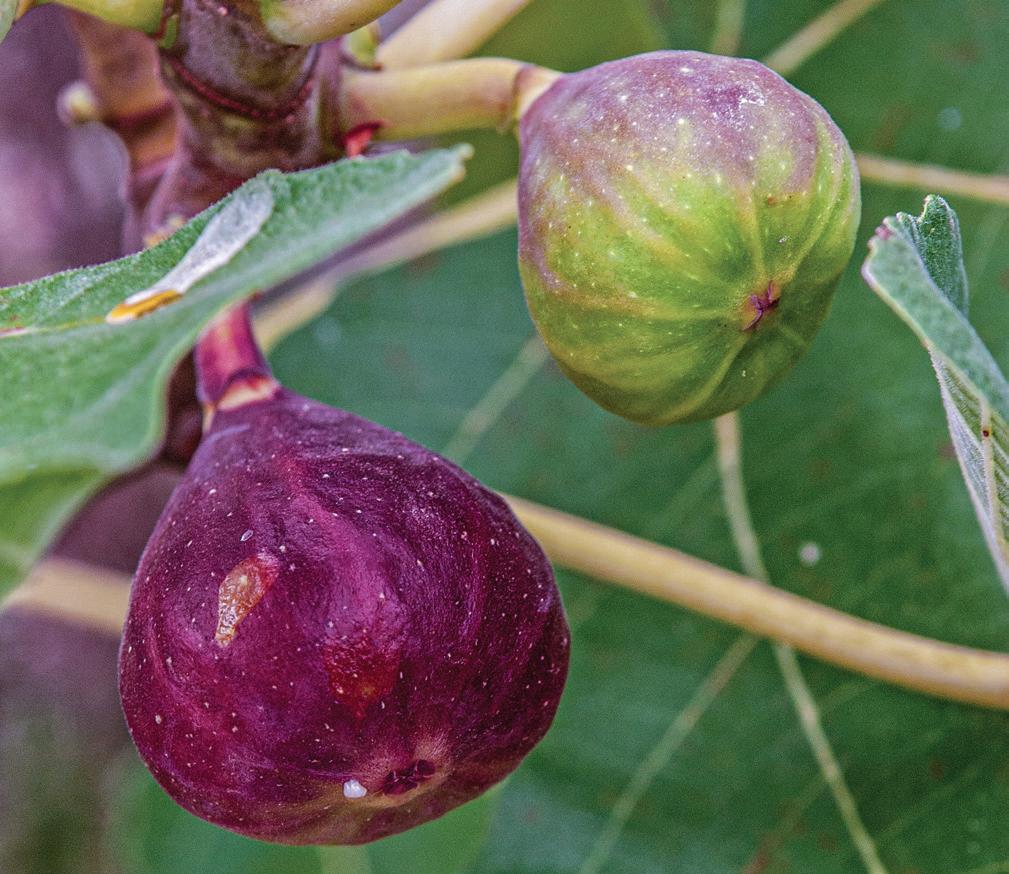MID-CAROLINA ELECTRIC COOPERATIVE



Ensuring the life of the hive—and the hive of life—continues thriving

Powering through summer
SC RECIPE
Grillin’ and chillin’
HUMOR ME
Catering to the bride
Jitterbug® phones feature large screens with big text, simple menus with effortless navigation, powerful speakers, and Urgent Response buttons. The Jitterbug® Flip2 has big buttons with one-touch speed dialing, while the Jitterbug® Smart4 comes with voice typing, video chat and internet access.
Whether you want to learn more about your phone, need a ride or have a health concern, our 100% U.S.based team is here to help, day or night. And when you add Urgent Response, enjoy peace of mind knowing you can count on us 24/7, even in an emergency.

• Fast, reliable nationwide coverage
• No long-term contracts
• No cancellation fees
• Keep your phone number2

THE MAGAZINE FOR COOPERATIVE MEMBERS
VOLUME 79 • NUMBER 6 (ISSN 0047-486X, USPS 316-240)
Read in more than 620,000 homes and businesses and published monthly except in December by
The Electric Cooperatives of South Carolina, Inc.
808 Knox Abbott Drive Cayce, SC 29033 (803) 926 -3175 fax: (803) 796 - 6064
letters@scliving.coop
EDITOR
Sarah Ellis Owen (803) 739-3040
sarah.owen@ecsc.org
FIELD EDITOR
Josh P. Crotzer
PUBLICATION COORDINATOR Sierra Hayes
ART DIRECTOR
Sharri Harris Wolfgang
DESIGNER
Rachael Arblaster
PRODUCTION
Andrew Chapman
EDITOR
WEB
Chase Toler
COPY EDITORS
Jennifer Jas, Jim Poindexter
CONTRIBUTORS
Miranda Boutelle, Mike Couick, Hastings Hensel, Jan A. Igoe, L.A. Jackson, Belinda Smith-Sullivan
PUBLISHER Avery Wilks
ADVERTISING
Hyatt Drake (803) 260-3393 ads@scliving.coop
NATIONAL REPRESENTATION
American MainStreet Publications (512) 441-5200
Paid advertisements are not endorsements by any electric cooperative or this publication. If you encounter a difficulty with an advertisement, inform the Editor.
ADDRESS CHANGES: Please send to your local co-op. Postmaster: Send Form 3579 to Address Change, c/o the address above.
Periodicals postage paid at Columbia, S.C., and additional mailing offices.
© COPYRIGHT 2025. The Electric Cooperatives of South Carolina, Inc. No portion of South Carolina Living may be reproduced without permission of the Editor.
SOUTH CAROLINA LIVING is brought to you by your member-owned, taxpaying, not-for-profit electric cooperative to inform you about your cooperative, wise energy use and the faces and places that identify the Palmetto State. Electric cooperatives are South Carolina’s — and America’s — largest utility network.
ANNUAL SUBSCRIPTIONS: $4.95 members, $8 nonmembers

Growing the population of bees is critical to sustaining life as we know it. Peek inside the life of the hive with SC’s Macri Honey Bee Farm.
Updates from your local co-op.
Building or buying a new home? Make energy efficiency a priority from the start to create future savings and make living more comfortable.
Stories with an old friend
In an increasingly digital world, nothing can replace that feeling of holding pages in your hands—pages that share wonderful stories about the people and places around you.
Grillin’ and chillin’
Summer’s all about outdoor fun and relaxation. Fire up the grill and just wait until the neighbors come wandering over for a taste.
Tips to beat the energy peak
As energy demand grows, we can all do our part to use less (which can save money, too).
Enter for your chance to win a getaway in SC’s Upcountry— with some extra perks!


Growing turtles
Head-turning turtlehead plants can bring splashes of color and intrigue to your garden. Plus, a new use for your garden tools.
Beware of the bride
Sure, a DIY wedding sounds great—until you’re the one on kitchen duty, Jan A. Igoe reminisces in this classic column from February 2010.

queen bee

mcecoop.com
LEXINGTON OFFICE
P.O. Box 669
254 Longs Pond Road Lexington, SC 29071
DUTCH FORK OFFICE
7524 Broad River Road Irmo, SC 29063
CUSTOMER SERVICE
(803) 749-6400
(888) 813-8000 Toll Free
GENERAL INFORMATION (803) 749-6555 (888) 813-9000 Toll Free
REPORT OUTAGES (803) 749-6444 (888) 813-7000 Toll Free
BOARD OF TRUSTEES
Marvin W. Sox, Chairman
Alan R. Lunsford, Vice Chairman
Donette B. Kirkland, Secretary
J. Allan Risinger, Treasurer
J. Carey Bedenbaugh, Jr.
Eddie C. Best, Jr.
Kenneth E. Lindler
Mark A. Svrcek
Justin B. Watts
CHIEF EXECUTIVE OFFICER
Bob Paulling
The mission of Mid-Carolina Electric Cooperative, Inc., a not-for-profit member-owned electric distribution utility, is to deliver reliable, costefficient utilities and innovative solutions to our members.
Mid-Carolina Electric is an equal opportunity provider and employer.
CO-OP NEWS EDITOR
Katrina Goggins katrina@mcecoop.com

JUNE BRINGS both new beginnings and meaningful milestones. For students, it often marks the end of another school year and the arrival of summer, a season filled with celebration, reflection and the excitement of what lies ahead. At Mid-Carolina Electric, we’re proud to support that journey by annually awarding scholarships to outstanding students from our service territory.
This year, each of our seven recipients will receive $4,000 to help with the cost of attending the college or university of their choice. We’re thrilled to recognize the hard work, commitment and community spirit these students have shown. Congratulations to our 2025 scholarship winners:
X Addison Cook, Lexington High School
X Rylan Cullum, Homeschooled
X Maple Erickson, Chapin High School
X John Gardner IV, River Bluff High School
X Caroline Hoffman, Brookland-Cayce High School
X Owen Roddy, Spring Hill High School
X William Wang, Dutch Fork High School
While June brings celebratory events such as graduations and summer holidays,



it also reminds us of the road ahead. June 1 also marks the start of hurricane season, when preparation becomes essential not just for first responders but for each of us as electric cooperative members.
We urge you to stay storm-ready by visiting our Storm Center at mcecoop.com There, you’ll find tips on how to prepare your home, what to do during outages and how to report them efficiently. If you’re not enrolled in TextPower, we encourage you to sign up for this easy-to-use text messaging service that lets you report outages from the convenience of your mobile phone. Our crews are always preparing, training and standing ready to serve when you need us most.
As we step into summer, let’s take a moment to appreciate all we’ve achieved so far this year and look forward with hope, gratitude and resilience. Thank you for being part of the Mid-Carolina family. We’re proud to serve you.








REPORT POWER OUTAGES WITH A SINGLE TEXT.
Summer storms are a fact of life in the Southeast. So we’re happy to share a user-friendly tool to help ensure your service gets restored as quickly as possible.
If you aren’t already enrolled in TextPower, now’s the time to sign up. Text “MCEC” to (803) 749-6555 right now. Our system will register your address and if a storm does ever interrupt your service, all you’ll have to do is text “out” to the same number. This way we can prioritize response units and be in your corner when you need it most.
PRIORITIZING ENERGY EFFICIENCY when building a new home might cost a little more upfront but can create future savings and make living more comfortable.
Several efficiency certifications are available for new-construction homes that may qualify for discounted homeowners insurance, tax credits and other incentives:
u Homes certified in Leadership in Energy and Environmental Design (LEED) prioritize sustainable resources and healthy indoor air quality. They use 20% to 30% less energy than the average home with some homes saving up to 60%. And construction can cost the same as non-LEED homes with proper planning, according to the U.S. Green Building Council.
u Passive House certification requires a home to be so efficient it needs little to no heating and cooling equipment while remaining comfortable for its occupants. For a home to achieve up to 90% less energy use than the average home, the certification focuses on maximizing the efficiency of

the building envelope all components that separate the indoors from the outdoors including proper insulation levels, air sealing and high-efficiency windows.
u ENERGY STAR NextGen certification recognizes houses that are 20% more efficient than the average home and help reduce greenhouse gas emissions by 40% to 80%.
Although various certifications are available, you don’t have to follow a set guide. Consider prioritizing these energy efficiency principles in your new home construction:
u Advanced framing techniques maximize the amount of insulated area and save on material costs in wood-framed homes. This can save hundreds of dollars in material costs, 3% to 5% on labor costs and up to 5% on annual heating and cooling costs, according to the U.S. Department of Energy. Choose a contractor familiar with these techniques, and check with local building officials to comply with local codes.
u Orient your home to the path of the sun to use less energy for heating and cooling, reducing energy bills and improving comfort, according to the International Association of Certified Home Inspectors.
u Request higher insulation levels in the attic if you are building or buying a new home that doesn’t allow options for orientation or framing. More insulation likely won’t cost much more for materials and labor, but it can help you use less energy and save money in the long run.
u Heating and cooling equipment should be properly sized using energy modeling tools that calculate the home’s needs. Investing in a well-insulated, air-sealed building envelope can reduce the home’s heating and cooling load, making it possible to have a smaller, less expensive heating and cooling system.
Optimizing the efficiency of a new home requires a whole-house approach. Analyze all systems and how they work together to ensure maximum efficiency for a safe and comfortable home. MIRANDA
BOUTELLE
MEMBERS SPEAK ON THE COOPERATIVE DIFFERENCE

HOMETOWN: Aynor
OCCUPATION: Farmer at Dixon Farms
Corey Dixon can trace his family farm’s history to before the Civil War, when his great-great-grandfather purchased property in rural Horry County in the mid-1800s. Decades later, Horry Electric Cooperative became a part of the family story when it delivered electricity to Dixon Farms for the first time.
Horry Electric watches out for the farmers.
—COREY DIXON
Today, Dixon is one of the farm’s owners and operators, growing sweet potatoes and tobacco on the same land his family has tended for six generations. Dixon says Horry Electric always goes the extra mile to help farmers like him when outages happen.
“Horry Electric, they usually watch out for the farmers and get your power back as soon as possible,” Dixon says.
Dixon grew up with Horry Electric members and employees. He has come to view the co-op as more than just a utility.
“It’s like they’re family,” Dixon says. “And when you call most times, everybody knows you.”
WHAT’S YOUR STORY?
Scan this QR code or visit SCLiving.coop/stories to share what you love about your co-op. Entries may be published in future issues of South Carolina Living, online and on social media.
Electric co-op service density compared to other electric utilities S.C. electric cooperatives
Electric cooperatives maintain more power lines per consumer than other types of electric utilities.
Even though we serve fewer consumers per mile of line, we always go the extra mile for our members.
13
Average number of consumers served per mile of line
Other S.C. electric utilities
39
Average number of consumers served per mile of line


MIKE COUICK
President and CEO,
The Electric
Cooperatives of South Carolina
In our past and present, we are a state made up of remarkable, independent people grown from rich and beautiful traditions and histories.
WHEN I WAS A KID, my Great-Aunt Jenny had what many today would call a side hustle. During the week, she worked at a high-end women’s clothing store in Rock Hill, but on the weekends, she would visit everyone she knew, selling Avon products and encyclopedias.
She’d come by our house nearly every Sunday, toting a free sample from Avon. She never failed to persuade my mom to make a purchase. I’m grateful for Aunt Jenny’s superior marketing abilities. Often, when I was supposed to be sleeping, I’d instead have a flashlight under my covers, illuminating a volume of the World Book Encyclopedia. Those encyclopedias fueled a love of learning and reading that I seem to have inherited from both of my grandfathers. My dad’s father was a carpenter in Lancaster County who started his work every day by 6 a.m. But first, he chiseled through that day’s Charlotte Observer newspaper while eating breakfast.
My mom’s father was a row crop farmer who waited until after lunch to sit down in his Naugahyde recliner and read three things: the South Carolina Farm Bureau’s Market Bulletin, the King James Bible and Living in South Carolina the original title of our statewide electric cooperative magazine.
My grandfather introduced me to Living and, within it, the column “Boys Are That Way” by James M. Eleazer. What I couldn’t learn in the encyclopedias such as how to catch a crawdad I’d pick up from Eleazer’s stories about growing up in rural South Carolina. (By the way, if you’re wondering, partially submerge an open mason jar into the water behind the crustacean and back it into the jar with the lid.)
A lot has changed since those days, particularly how we consume information and how we are exposed to stories that inspire us. In most cases, analog words on a page have given way to digital pixels on a screen.
We’ve reached an age when many, if not most, of us no longer find a local daily newspaper in the driveway. The very encyclopedias that taught us about dinosaurs are now proverbial dinosaurs. Local, independent bookstores are trending in a similar direction. Flipping through dozens of
algorithm-curated, short videos is now how many of us pass the time on a rainy day.
Perhaps I’m getting old and technology has taken a turn I don’t appreciate, but I still prefer the tactile experience of flipping through the pages of a print publication and even picking up the faint scent of ink.
That’s why I’m glad South Carolina Living is still going strong. Like an old friend who drops by once a month to share colorful stories and reminisce on the good old days, it reliably arrives in your mailbox and on your doorstep. (If you’re so inclined, it is also available online at scliving.coop.)
After more than 75 years, it still delivers great information we often hear about how much you love the recipes and wonderful stories about the people around you. Since arriving at South Carolina Living last summer, magazine editor Sarah Owen has continued the magazine’s legacy of telling the story of loving living here.
My peach-farming grandfather would have enjoyed our profile earlier this year of Clara Dixon Britt, who once rode a bull to St. George’s Rosenwald School to keep her perfect attendance. I can hear him saying, “She is made out of the right stuff!”
I’m especially fond of the recent cover feature about “Liberty Mountain,” the small, long-running theater production recounting the Revolutionary War’s Battle of Kings Mountain. Stories like that preserve our knowledge of our heritage and the role South Carolina men and women have played in America’s rich history.
In our past and our present, we are a state made up of remarkable, independent people grown from rich and beautiful traditions and histories. In a time when it’s easier to connect to a screen than to one another, South Carolina Living fulfills an important role in sharing the personalities and experiences of your neighbors and fellow South Carolinians.






BY BELINDA SMITH-SULLIVAN
Summer is here, and it’s time to start thinking outside the house. This season is all about outdoor fun and relaxation. Get ready to fire up the grill, chill the drinks and invite your friends and neighbors to join in!

CITRUS SKIRT STEAK FAJITAS
SERVES 4
MARINADE FOR STEAK
1 orange, juiced
1 lime, juiced
2 garlic cloves, minced
¼ cup chopped fresh cilantro
½ cup olive oil, divided
1 teaspoon cumin
1 jalapeño, seeded and minced
1 skirt steak, 1½–2 pounds
Kosher salt
Fresh ground black pepper
FOR SERVING
1 onion, sliced
1 green bell pepper, sliced
2 red bell peppers, sliced
1 tablespoon olive oil
Lime wedges
6-inch tortillas
Guacamole
Salsa
Pico de gallo
Sour cream
Sliced avocado
In a small bowl, combine orange juice, lime juice, garlic, cilantro, olive oil, cumin and jalapeño. Dry off the steak with a paper towel. Season with salt and pepper. Put steak along with marinade in a zip-top bag and refrigerate up to 4 hours, turning occasionally. Preheat grill to medium-high and brush with oil. (This can also be done on the indoor stove with a grill pan.) Toss onions and peppers in oil and sauté, turning occasionally, until slightly charred. Remove from heat to a bowl or platter, cover with foil and keep warm.
Remove steak from marinade, pat dry, and discard marinade. Grill steak for 3–4 minutes for medium rare. Transfer to a cutting board and tent with foil, allowing meat to rest before cutting. Warm the tortillas in a hot cast-iron skillet until warm on each side, then wrap them in a clean kitchen towel to keep warm. Thinly slice steak against the grain and place on a large platter. Surround with peppers, onions and lime wedges. Serve alongside tortillas, guacamole, salsa, pico de gallo, sour cream and avocado.

DOUBLE-THICK PORK CHOPS WITH PEACH BARBECUE SAUCE
SERVES 4
SAUCE
¼ cup oil
1 sweet onion, chopped
3 garlic cloves, chopped
6 medium peaches, peeled and chopped
¾ cup packed brown sugar
½ cup apple cider vinegar
¼ cup bourbon
½ cup Worcestershire sauce
½ cup tomato sauce
½ teaspoon crushed red pepper
½ tablespoon chili powder
Kosher salt
Fresh coarse-ground black pepper
Juice from ½ lemon
Warm oil in a large saucepan over medium-low heat. Add onion and cook, stirring occasionally until tender, about 10 minutes. Add garlic and cook for 1 minute. Stir in peaches, sugar, vinegar and bourbon (or water). Bring to a boil over high heat, then reduce heat to medium. Add Worcestershire sauce, tomato sauce, red pepper, chili powder, salt and pepper. Simmer uncovered, stirring occasionally, until peaches and onion are very tender, about 30 minutes. Stir in lemon juice and let cool.
Working in batches, transfer the peach mixture to a blender and puree until smooth. Pour into clean jars and refrigerate up to two weeks.
CHOPS
4 thick (1½-inch) pork chops
Kosher salt
Fresh ground black pepper 2 tablespoons brown sugar, packed 2 teaspoons smoked paprika (aka Spanish paprika)
Canola oil, for grill
Rinse and pat dry chops. In a small bowl, combine salt, pepper, sugar and paprika. Rub a generous amount of seasoning all over chops. Wrap with plastic and refrigerate for 1–2 hours or overnight.
Preheat grill to medium-high and brush with oil. Place chops on direct heat side of grill, and cook about 15 minutes until grill marks appear. Turn and move to indirect heated side of grill, and cook until chops register 140 F on an instant-read thermometer, about 15–20 minutes. Brush chops with sauce on all sides, cover and cook about 5–10 minutes. Remove to a platter, brush with more sauce and tent with foil until ready to serve. Serve with additional sauce.
CHEF’S TIP Direct and indirect heat: Generally, on a large propane grill, only half the burners are turned on. The fire-producing burners provide direct heat, while the dormant burners provide indirect heat.

SPATCHCOCKED CHICKEN WITH LEMON GARLIC MARINADE
SERVES 4–6
1 small fryer (3 pounds), spatchcocked
2 tablespoons olive oil
2 tablespoons fresh-squeezed lemon juice (about ½ lemon)
2 garlic cloves, grated
1 teaspoon kosher salt
½ teaspoon fresh coarse-ground black pepper
1 teaspoon dried Italian seasoning or herbs de Provence 2 lemons, halved, for garnish
Pat dry chicken and place on a large sheet pan. In a small bowl, combine oil, lemon juice, garlic, salt, pepper and Italian seasoning. Rub seasoning all over chicken, gently loosening the breast skin and rubbing the seasoning under the skin.
Allow chicken to marinate while grill is heating to medium-high, and brush grill with oil. Grill chicken, skin side down, over direct heat until grill marks form and skin is crispy brown, about 20 minutes. Flip and cook, skin side up, until that side is brown and crispy, about another 20 minutes. (Cook longer if chicken is bigger.) Move chicken to indirect heat side of grill and continue to cook until temperature on an instant-read thermometer reaches 160–165 F. Remove from grill, place on a platter or cutting board and cover loosely with foil. The heat generated from grilling will continue to cook the chicken until it reaches 165 F, about 10 minutes. Grill lemons, cut side down, until grill marks form. Cut chicken into desired pieces. Serve on platter with grilled lemon halves.
CHEF’S TIP How to spatchcock a chicken:
Spatchcocking a chicken allows it to cook more evenly throughout the thigh and breast areas. Using a sturdy pair of kitchen shears, remove the backbone from the chicken by cutting down each side of the backbone from top to bottom. Open the chicken up, like a book, and flip over onto a clean cutting board. Holding the heel of your palm over the breast of the chicken, press down firmly to crack the breastbone (also known as the sternum) so the chicken will lie flat. (Alternatively, ask your butcher to do this for you.)

HALIBUT STEAKS WITH MANGO SALSA SERVES 4
SALSA
1 large mango, peeled, pitted and small diced
¼ small red onion, peeled and small diced
1 tablespoon jalapeño, finely diced
1 tablespoon chopped fresh cilantro
Juice of 1 lime
Kosher salt
Fresh ground black pepper
FISH
4 tablespoons unsalted butter, softened
1 teaspoon garlic powder
½ teaspoon paprika
Kosher salt
Fresh ground black pepper
1 teaspoon dried dill
1 teaspoon dried parsley
1 tablespoon fresh-squeezed lemon juice
4 halibut steaks (or flounder, haddock or cod)
Lemon wedges, for garnish
In a medium bowl, combine mango, onion, jalapeño, cilantro, lime juice, salt and pepper. Cover and refrigerate. (Make a day ahead, if possible, to enhance the flavor.)
Preheat grill to high and brush with oil. In a medium bowl, combine butter, garlic powder, paprika, salt, pepper, dill, parsley and lemon juice. Spread evenly on halibut steaks. Cook on preheated grill until flaky, 4 to 5 minutes per side. Remove to a platter and serve with salsa and lemon wedges.
BY MIRANDA BOUTELLE
QWhat does “beat the peak” mean, and why should I care about it?
AWhen your electric cooperative talks about “beat the peak,” it is a call to action to reduce electricity use during periods of highest demand. Using less energy during peak times can ease the strain on the electric grid, benefit your cooperative and sometimes lower your electric bill.
Electricity generation and energy supply must match real-time consumption to ensure safe, reliable power. Every moment of every day, an entire workforce monitors energy use, adjusting power plant production up or down as needed to keep the grid balanced.
Small changes at home can make a big difference to the energy grid. Incorporate these energy-wise habits into your daily routine.
As energy demand grows, we all can do our part to use less.
Peak times vary for each electric utility but typically occur in the morning when people get ready for the day and in the evening when they return home from work and school. During these times, we turn on lights, cook, adjust the thermostat, run the dishwasher and do laundry to name a few of our energyconsuming activities.
Typically, the price of power increases during those times when demand is higher. Reducing your electric use during peak times can lower market prices for everyone and lessen stress on the electric grid.
Electric cooperatives set electric rates to cover costs. Some utilities have timeof-use rates that reflect higher costs during peak demand periods. Whether or



not you have time-of-use rates, these tips can help keep costs down for you and your utility and establish off-peak energy habits.
n Try to spread out the use of equipment and appliances. For example, avoid washing dishes and clothes and cooking all at the same time. Running a lot of hot water will cause your water heater to use more energy, too.
n Increase your home’s energy efficiency to lower its impact on the grid. Weatherize windows and doors and add insulation to improve the comfort of your home. Consider upgrading to energy-efficient appliances or using energy-saving features on your existing appliances. If you haven’t already, switch your incandescent lighting to LED bulbs, which use at least 75% less electricity and last up to 25 times longer, according to the U.S. Department of Energy.
n Schedule your dishwasher run time. Your dishwasher may have a “delay start” button, which is also handy if your dishwasher is loud. Setting it to start after you go to bed shifts the energy consumption to off-peak hours, and you don’t have to hear it.


n Run your washing machine and dryer during off-peak hours, too. If you’re in the market for a new washer or dryer, look for a model with a high Integrated Modified Energy Factor and a low Integrated Water Factor to save water and energy.
n Charge your phone and other electronic devices during off-peak hours. If you have an electric vehicle, use the scheduled charge settings. Plug in your vehicle when you get home, and it will start charging automatically during the off-peak hours you choose.


Register for our Reader Reply Travel Sweepstakes and your chance to win a two-night getaway in the Upcountry!
If you are the winner, you’ll enjoy:
u Two nights’ lodging at the Laurel Mountain Inn in Pickens. This quaint inn sits at the base of Table Rock Mountain and on the Cherokee Foothills National Scenic Byway, so it is the perfect spot to begin exploring the many beautiful sights nearby, such as Table Rock State Park, Sassafrass Mountain, Lake Jocassee, and several waterfalls. laurelmountaininn.com
u $100 gift card at a Table 301 Restaurant Group location. From fun to fancy, six restaurants in Greenville and Mauldin are ready to delight your tastebuds with Italian, seafood, Mediterranean or contemporary Southern cuisine. table301.com/restaurants
u Use of a BMW Sport Activity Vehicle during the getaway.
A drive through the foothills of the Blue Ridge Mountains will be even more enjoyable while riding in a BMW Sport Activity Vehicle (SAV) that was assembled a few miles away at BMW Manufacturing in Greer, S.C. bmw.com
u And South Carolina Living will add a $100 gift card that spends like cash anywhere Mastercard is accepted.



To enter, scan the QR code, register at SCLiving.coop/reader-reply, or use this mail-in form. We’ll randomly draw the name of one lucky reader from all eligible entries received by June 30, 2025.
By entering, you agree to join the South Carolina Living email list and abide by our full sweepstakes rules, found at SCLiving.coop/rules.

n a mild afternoon as spring begins to burst into bloom, beekeeper Mike Macri makes his rounds to check on his 30 beehives. All about him, honeybees swarm and buzz, but Macri moves among them with the nonchalance of a man who’s been stung a thousand times.
He stops at “Hive 5” one of his “docile” hives and issues a few puffs from a handheld smoker. He stands back, hooded in his beekeeping suit, and lets the smoke calm the creatures. Then, with a hive tool, he pries open the top of the wooden box, which the bees have sealed with a waxy substance called propolis, or “bee glue.” Inside, 10 wooden frames are stacked vertically, like old pictures in an attic box, and Macri carefully lifts them out, one at a time.
Within each frame, the honeybees have built a honeycomb one of nature’s most marvelous feats of architecture and there’s only one way to describe what’s happening: The bees are busy as bees. Some are feeding the young. Some are feeding the one and only queen. Some are cleaning the cells of

the hive. Some are heading out on scouting trips to nearby flowers.
Macri guesses there are around 60,000 to 80,000 bees in this hive alone, an entire colony that seems to be performing a complex dance in anticipation of the upcoming spring’s honey flow
But Macri is quick to point out that honey is only one aspect of beekeeping.
“I mean, yeah, we do honey,” he says, referring to Macri Honey Bee Farm, which he runs just outside of Conway with his wife, Joanne. “But my main concern is to make the bee populations grow.”
Here he offers up his favor ite quote something he’s as fond of saying as he is of showing off the honeybee tattoo on his left arm. “You know,” he says, “Einstein once said, ‘If bees die, we die four years after them.’ ”
Like most beekeep ers, Macri sees beekeeping as more than a simple pastime or hobby, and he will wax lyrical about how bees pollinate our plants as part of “the great circle of life.”


‘THE

“Of all the agricultural p ractices we have, honeybees and beekeeping have the lightest footprint and the greatest benefit.”
BEN POWELL, COORDINATOR OF THE CLEMSON APICULTURE AND POLLINATOR PROGRAM
certain enzymes in their glands, and blow this mixture into one of the cells of the honeycomb, and fan it down to a moisture content of around 17%, they will cap the cell with wax. Voila: their nonperishable winter food, honey.
8
Estimated number of honeybee species worldwide, out of some 20,000 bee species overall.
“This year, we helped put bees on a strawberry farm,” he says. “The farmer told me yesterday, he goes, ‘Boy, my strawberries
Bites of food that have been pollinated by bees.
It’s an intricate web of give-and-take, of work-and-make, and beekeepers don’t just come in at the end to scrape the comb for honey. Beekeepers are there to ensure that the life of the hive and the hive of life continues to thrive.
—BEEKEEPER MIKE MACRI
“ It’s crazy what God’s l ittle creature does to our whole food survival.”
have never looked so good.’ You not only get more berries when you have bees; you get bigger berries.”
Strawberries, peach trees, cucumbers, squash, Brussels sprouts, broccoli, cauliflower these are just some of the crops that depend on honeybees as insect pollinators. With nectar and pollen, the bees use the mixture to make “bee bread,” which they feed to their larvae and their queen. And when honeybees mix nectar with
$20 billion
Estimated value of honeybees’ contribution to U.S. crops annually.
5–6 weeks
Average lifespan of a worker bee, during which time she’ll produce about 1/12 teaspoon of honey.
2,500
Number of eggs a queen can lay per day in the busiest summer months.
SOURCES: THE BEE CONSERVANCY, CLEMSON APICULTURE AND POLLINATOR PR OGRAM, NATIONAL GEOGRAPHIC KIDS
Ben Powell, coordinator of the Clemson Apiculture and Pollinator Program, puts it this way: “Having honeybees in your landscape improves the ecosystem, and of all the agricultural practices we have, honeybees and beekeeping have the lightest footprint and the greatest benefit.”
All of this is why the current news about honeybees is, well, stinging. Bees are dying off in alarming numbers across the country, and although thousands of labs are researching the causes, no one knows why.
At a recent monthly meeting of the Blackwater Beekeepers Association, one of 26 local beekeeping associations in South Carolina, President Rick Vereen shared the latest data. Colony losses over the past winter were drastically higher than usual, and commercial beekeepers had suffered hundreds of millions of dollars in lost revenue. uu
“For commercial beekeepers, this is very significant,” Clemson’s Powell says. “They’re losing 40% of their stock. Imagine if you were a chicken farmer or cattle rancher. If you lost 40% of your animals every year, that’s a significant loss. And so, beekeepers have some challenges, but beekeepers are also very hardworking and industrious people, and they’re working diligently to overcome those losses.”
Powell emphasizes that people can support pollinators, even if they aren’t bee keepers, by being conscious of how they manage their land. They can build native plant gardens and reduce pesticides. They can maintain biodiversity by replacing plants that aren’t very productive for pollinators. They can call a beekeeper when they see a swarm of bees, rather than exterminate it.
Do it yourself


STICKY BUSINESS To get a jar of golden honey, the wax is first scraped off the comb, then the combs are spun at a high speed to extract the honey.

“Beekeeping, to me, i s like being an artist. Every artist puts their paint on the canvas differently.”
And if people are interested in becoming a beekeeper?
“If you want to be serious about getting into learning about how to manage bees, produce honey and keep bees either for a trade or for income, my main suggestion is that you look for a local club or a local class,” Powell says. “That’s the best way to learn how to keep bees in South Carolina.”
Macri agrees. He believes the No. 1 thing any budding beekeeper can do is find a good mentor. Or, better yet, several mentors.
“Beekeeping, to me, is like being an artist,” he says. “Every artist puts their paint on the canvas differently. Well, you take what you learn from here and there, and you make it your own. You do it your way what works for you, what’s simplest for you.”
As Macri is saying this, he finally finds the queen inside one of the frames of “Hive 5.” She’s noticeably larger than all the other bees, and sure enough, she has an unmistakable green rump. He tells Joanne to checkmark “Spotted Queen” on this hive’s

YIELD: 6–8 MUFFINS
1½ cups white flour
2 teaspoons baking powder
Dash of salt
1 egg
½ cup local honey
½ cup skim milk
¼ cup canola oil
1 cup blueberries (optional)
Preheat oven to 350 F. Grease a 12-count muffin pan or line with cupcake papers.
In a bowl, whisk together flour, baking powder and salt. Set aside. In another bowl, whisk together egg, honey, milk and oil. Add in flour mixture and mix until just combined. Divide batter evenly into 6–8 cups of the prepared pan (fill about ¾ full). Bake 15–20 minutes or until a toothpick inserted comes out clean.
Let muffins cool for five minutes before removing from pan. Keep leftovers in a covered container.
—BEEKEEPER MIKE MACRI
inspection checklist, which also includes such items as “Brood Pattern,” “Mites,” “Hive Beetles” and “Demeanor” each a potential issue he must monitor.
One problem beekeepers face is a fascinating phenomenon known as “swarming.” This occurs when the hive becomes overloaded and splits to make a new hive elsewhere. During a swarm, the old queen will take half the bees and leave, thus drastically reducing honey production.
Macri, for his part, isn’t concerned about any potential swarm today. He closes “Hive 5” and moves on to inspect the next one.
In the coming weeks, the bees will fill each comb with honey and then cap it with wax, almost like sealing the lid of a jar. Macri will take these honeycombs (called “supers”) and walk them over to his “Honey House” a storage shed in which he has an extractor and a bottler. He’ll scrape the wax off the comb and let the extractor spin out the honey. He’ll bottle it up in 16-ounce jars, which he gives to friends and sells locally.
But he will also keep a good bit of honey for the bees themselves. After all, that’s how they’ll survive the winter. And we need the bees to live, if we want to live.
As Macri puts it, “It’s crazy what God’s little creature does to our whole food survival.”





JUNE
19–21 Juneteenth Celebration, various locations, Spartanburg. (864) 596‑2000 or cityofspartanburg.org.
20–29 Murder, Plain and Simple, Centre Stage Theatre, Greenville. (864) 233‑6733 or centrestage.org.
21 Americana Folk Festival, Hagood Mill Historic Site, Pickens. (864) 898‑2936 or visithagoodmill.com.
21 Comedian Jerry Carroll, Abbeville Opera House, Abbeville. (864) 366‑9673 or abbevillecitysc.com.
21 Juneteenth: A Cultural Celebration, Mauldin Cultural Center, Mauldin. mauldinculturalcenter.org.
21 Moonlight Paddle, Oconee State Park, Mountain Rest. (864) 638‑5353.
26–28 South Carolina Festival of Stars, Main and Saluda streets, Ninety Six. (864) 543‑2200 or townofninetysix.sc.gov/ sc festival stars.
27–28 Art Feeds the Soul Annual Quilt Show, Seneca Middle School, Seneca. lmqg.org.
28 Fairforest 5K, Croft State Park, Spartanburg. (864) 585‑1283.
28 Freedom Blast, Greer City Park, Greer. freedomblast.org.
JULY
3 Clemson MBA Fireworks, Unity Park, Greenville. (864) 232‑2273 or greenvillesc.gov.
3 Fourth of July Spectacular, downtown, Fountain Inn. mainstreetfountaininn.com.
5 Celebration of Freedom, Cowpens National Battlefield, Cowpens. nps.gov/cowp/index.htm.
9–19 South Carolina Peach Festival, various venues, Gaffney. southcarolinapeachfest.com.
10–12 South Carolina Festival of Discovery, Main Street, Greenwood. (864) 942‑8448 or uptowngreenwood.com.
12–Aug. 2 Laser Days of Summer at the Planetarium, Roper Mountain Science Center, Greenville. ropermountain.org.
19 Banjo Extravaganza, Hagood Mill Historic Site, Pickens. (864) 898‑2936 or visithagoodmill.com.
24–Aug. 10 Million Dollar Quartet, Centre Stage Theatre, Greenville. (864) 233‑6733 or centrestage.org.
Our mobile-friendly site lists even more festivals, shows and events. You’ll also find instructions on submitting your event. Please confirm information with the hosting event before attending.
26–Aug. 2 Senior League Baseball World Series, J.B. Red Owens Sports Complex, Easley. littleleague.org/world series/2025/ slbws.
JUNE
20 Aiken Master Gardener Lunch Box: Hurricane Helene Recovery Efforts in Hitchcock Woods, Millbrook Baptist Church, Aiken. (803) 508‑7739 or aikenmastergardeners.org.
20 Summer Nights at the Museum, South Carolina State Museum, Columbia. (803) 898‑4921 or scmuseum.org.
20–21 The Dam Boat Run, Lake Murray, Columbia. lakemurraypowerboatrun.com.
20–22 Juneteenth Rock Hill Festival, various locations, Rock Hill. facebook.com/juneteenthrockhill.
20–July 26 Elton John and Tim Rice’s Aida, Trustus Theatre, Columbia. (803) 254‑9732 or trustus.org.
21 Columbia Shrimp & Grits Fest, Seawell’s, Columbia. columbiashrimpandgrits.com.
21 Juneteenth Freedom Fest & Parade, downtown, Columbia. juneteenthfreedomfest.com.
21 Ridge Peach Festival, downtown, Trenton. ridgepeachfestival.org.
27–28 WSO Theatre and Film Festival, Harbison Theatre, Columbia. (803) 407‑5011 or harbisontheatre.org.
27–28, July 4–5 The Hunchback of Notre Dame, Rock Hill Theatre, Rock Hill. (803) 326‑7428 or rockhilltheatre.org.
28 Great American Campout, 2573 Lake Haigler Drive, Fort Mill. (803) 547‑4575 or ascgreenway.org.
28 Lake Murray’s Independence Day Celebration, Lake Murray, Columbia. (803) 781‑5940 or lakemurraycountry.com.
28 The Lizard Man Stomp, downtown, Bishopville. (803) 484‑6359 or facebook.com/lizardmanstomp.
JULY
4 4th of July Fireworks Show, Lake Wateree State Park, Winnsboro. (803) 482‑6401.
4 Fort Jackson Independence Day Fireworks Celebration, Fort Jackson, Columbia. jackson.armymwr.com.
4 Independence Day, Colonial Style, Living History Park, North Augusta. colonialtimes.us.
4 Lexington County Peach Festival, Gilbert Community Park, Gilbert. lexingtoncountypeachfestival.com.
4–5 U.S. of Cay 4th of July Celebration, various locations, Tega Cay. (803) 548‑1400 or tegacaysc.org.
11–19 A Bad Year for Tomatoes, Aiken Community Theatre, Aiken. (803) 648‑1438 or aikencommunitytheatre.org.
12 Battle of Huck’s Defeat Commemoration, Historic Brattonsville, McConnells. (803) 329‑2121 or chmuseums.org/brattonsville.
19 Moths of Lee State Park, Lee State Park, Bishopville. (803) 428‑4988.
20 Summer Nights at the Museum, South Carolina State Museum, Columbia. (803) 898‑4921 or scmuseum.org.
26–27 The Big Plant Expo, South Carolina State Fairgrounds, Columbia. (803) 799‑3387 or serareplantmarket.com.
JUNE
20 Reggae Nights Summer Concert: Da’Gullah Rootz, James Island County Park, Charleston. (843) 795‑4356 or ccprc.com.
22 Florence Symphony Rocks!, Francis Marion Performing Arts Center, Florence. (843) 661‑4444 or fmupac.org.
25 America Sings!, First Presbyterian Church, Hilton Head Island. (843) 341‑3818 or hiltonheadchoralsociety.org.
26 Sweetgrass Festival, Memorial Waterfront Park, Mount Pleasant. (843) 884‑8517 or experiencemountpleasant.com.
26–27 Folly Beach Wahine Classic, 1550 E. Ashley Ave., Folly Beach. follywahine.com.
28 Carolina Day Commemoration of the Battle of Sullivan’s Island, Fort Moultrie, Sullivan’s Island. (843) 883‑3123 or charlestoncvb.com.

As part of its “Summer Light: Art by Night” showcase, Brookgreen Gardens is hosting the exhibit “Gardens of
28 Conway Riverfest, downtown, Conway. (843) 248‑2273 or conwayriverfest.com.
28 DragonBoat Beaufort Race Day, Waterfront Park, Beaufort. facebook.com/dragonboatbeaufort.
28 Freedom Fest, Public Square, Darlington. darlingtonchamber.com.
28 Independence Celebration, Regional Recreation Complex, Moncks Corner. (843) 719‑7952 or monckscornersc.gov.
JULY
4 4th of July Fireworks Blast, Patriots Point, Charleston. (843) 884‑2727 or patriotspoint.org.
4 Firecracker 5K, Honey Horn Park, Hilton Head Island. hiltonheadfirecracker5000.com.
4 Fourth of July Fireworks, Harbour Town, Hilton Head Island. (866) 561‑8802 or seapines.com.
4 Independence Day 5K and Fun Run, Grand Park Lake Courtyard on Farrow Parkway, Myrtle Beach. runsignup.com.
4 Salute From the Shore, Cherry Grove to Bluffton. salutefromtheshore.com.
9–Aug. 17 Summer: The Donna Summer Musical, Arts Center of Coastal Carolina, Hilton Head Island. artshhi.com.
11–20 Beaufort Water Festival, Waterfront Park, Beaufort. bftwaterfestival.com.
12 Fort Motte Exhibition Opening, Morris Center for Lowcountry Heritage, Ridgeland. morrisheritagecenter.org.
18 Dancing on the Cooper, Mount Pleasant Pier, Mount Pleasant. (843) 795‑4356 or ccprc.com.
19 Caribbean Jerk Festival, Riverfront Park, North Charleston. chsjerkfest.com.
19 IOP Beach Run, IOP Recreation Center, Isle of Palms. (877) 607‑6467 or iop.net.
19–20, 26–27 Diary of a Wimpy Kid, Dock Street Theatre, Charleston. (843) 577‑7183 or charlestonstage.com.
20 Reggae Nights Summer Concert: Well Charged, James Island County Park, Charleston. (843) 795‑4356 or ccprc.com.
21 Paul Reiser, Arts Center of Coastal Carolina, Hilton Head Island. artshhi.com.
24–25 May River Shrimp Festival, Bluffton Oyster Factory Park, Bluffton. bluffton.com.
ONGOING
Through Aug. 30 Summer Light: Art by Night, Brookgreen Gardens, Murrells Inlet. brookgreen.org. Through Oct. 5 “Picturing Freedom: Harriet Tubman and the Combahee River Raid,” The Gibbes Museum of Art, Charleston. (843) 722‑2706 or gibbesmuseum.org.











n Make rakes, hoes and shovels even more useful in your garden by marking the handles with paint, permanent marker, or waterproof tape in inch increments. This gives you handy measuring devices to use when it comes to correctly establishing row widths as well as planting distances and depths.
n If you remove some of the stem suckers off the lower portions of your tomato plants and tuck them away in individual pots filled with moist dirt in a semi-shady spot, many will root and, in about a month, be ready as transplants that are exact clones of the momma plant for the midsummer veggie patch.

OF THE MONTH Thinking about adding a fig tree to your edible garden? Plant it in a well-draining site in full sun, and keep in mind a young fig tree can take a few years to swing into full fruit production. Since maturing fig trees are sensitive to drought, add mulch and water during the dry times. Typical fig trees can reach 15 feet or more in both height and width, so to prevent them from becoming botanical beasts, prune about a quarter of their growth every few years in late winter, cutting back limbs to leaf or branch joints. “Brown Turkey” and “Celeste” are two popular cultivars.

BY L.A.
I AM SURE THAT, ON OCCASION, you have spotted a turtle or two moseying around your plant beds. Although they are slow, their visits are usually brief. If you enjoyed those fleeting moments, why not just add turtleheads to your garden?
No, I’m not talking about doing vile things to cute critters. Instead, I suggest a plant called turtlehead (Chelone spp.). It is an herbaceous perennial native to the Southeast that has hooded blossoms that look like with some imagination on your part turtle heads with their mouths open.
Even with its odd name and look, turtlehead is a rather pretty plant. But you have to wait until midsummer for visual satisfaction, when its clustered blooms supported on 2- to 3-foot stems begin to open, starting a pleasing show that can last over a month.
Turtleheads (deer-resistant, by the way) perform best in sunny to semishady gardens. But unlike many other plants, they will even grow well in soggy soil, making them a great addition to rain gardens or low spots in the landscape that turn to muck when it rains. Also, they are obvious options as marginal plants in a water garden.
If the flowers are left to go to seed, your turtlehead patch will continue
to grow, just as long as the soil is kept moist to help encourage new sprouts. In addition, turtleheads can slowly expand their clumps by way of underground rhizomes. And if you want extra turtleheads for other parts of your landscape or to give away to friends, the plants can be propagated by divisions taken in early spring just as new growth begins to appear.
Three turtlehead varieties are typically available at garden shops. Pink turtlehead (Chelone lyonii) is the most common meaning easiest to find and in particular, the cultivar “Hot Lips,” which is quite a cutie with lightrose flowers hovering over rich green foliage. Prefer white blooms? Chelone glabra will deliver with its pleasant pale blossoms. There is even a so-called red turtlehead (Chelone obliqua), but the ones I have seen had flowers that were more a deep pink than a flashy red.
Turtleheads shouldn’t be too hard to find at area nurseries, especially ones that specialize in native plants. But if your local hunt comes up empty, these strange, charming beauties are easy online finds.
L.A. JACKSON is the former editor of Carolina Gardener magazine. Contact him at lajackson1@gmail.com.














BY JAN A. IGOE
WHEN MY DAUGHTER DECIDED she wanted a do-it-yourself wedding at the beach, everybody loved the idea. We didn’t realize it meant Daddy would be the designated turkey fryer and 57 relatives would supply macaroni and cheese.
I’ve entertained a lot of fantasies about what my daughter’s wedding would be like, but none of them included me strangling scallops with bacon on her big day. My fantasies starred professional caterers who know how to roast prime rib and marinate meatballs simultaneously without setting the reception hall on fire. When shells show up in the crab cakes, you need people to blame who aren’t your cousins, as any wedding planner will tell you.
But I didn’t dare push the issue, because the golden rule of prenuptial peace is not to argue with the bride, who might hurt you if you happen to be her mother.
Any female no matter how naturally sweet, lovable and easygoing she was prior to her engagement becomes a ticking time bomb under the pressure of ordering monogrammed M&M’s to match the groom’s cummerbund. No one knows what teeny detail might push the bridal brain over the edge.
If a normally law-abiding bride-to-be got up one morning and decided to rob a bank, she could just tell the judge she needed extra cash for her cake topper and plead “Premarital Insanity.” She’d get off with the court’s deepest apologies for her inconvenience, as long as she promised to leave before exploding.
So, in the interest of self-preservation, her dad and I just started nodding in agreement with every word our deranged baby girl uttered six solid months before the wedding.
She didn’t want bridesmaids, since it was too difficult to find dresses that flattered everyone’s tattoos. The only members of the wedding party would be her

In the interest of selfpreservation, her dad and I just started nodding in agreement with every word our deranged baby girl uttered six solid months before the wedding.
two Labrador retrievers sporting casual beach attire. And the only rule of etiquette that concerned her was making sure the ceremony would be properly Facebooked, Twittered and blogged. Thankfully, she didn’t want me anywhere near the kitchen. My only job was to decorate the groom’s car after the ceremony on the big day, which came before we knew it.
We couldn’t have asked for better weather. The warm sunshine was perfect for guests to wait around the beach for the father of the bride, who was still frying fowl when he was supposed to be giving the bride away. The delay also gave the bridal party time to eat their outfits.
By the time the bride and groom said “I do,” we’d transformed the groom’s black Honda into the picture-perfect wedding mobile. A couple of artistic nephews helped me attach streamers and balloons and stencil hearts all over the car.
We knew the newlyweds would be thrilled with our masterpiece, until they slipped into the other black Honda parked across the lot. My nephews and I backed away from our work and watched as two guys we’d never seen before drove off in our “Just Married” mobile.
We hustled over to the reception, where the party was already going strong and none of the little snafus seemed to matter anymore. Months of craziness were finally over, and the radiant bride was returning to her sane, lovable self. Life was good.
And then her sister caught the bouquet.
EDITOR’S NOTE: South Carolina Living is reprinting some of Jan A. Igoe’s previous columns. This “Humor Me” originally appeared in the February 2010 issue. Visit SCLiving.coop/news/ in-memory-of-jan-igoe


It’s good to know your Touchstone Energy® Cooperative is always there. For generations we’ve powered the growth of our neighborhoods, businesses, and everything in between. Today our commitment is stronger than ever to provide affordable and reliable energy on which you can depend.
